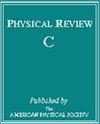全面分析预复合发射:壳封闭和目标变形的作用
IF 3.4
2区 物理与天体物理
Q1 Physics and Astronomy
引用次数: 0
摘要
目前关于低能反应动力学的研究工作认识到,即使在能量低至≈4-5 MeV/核子的情况下,复合前发射作为发射高能粒子的一个最重要的激发过程也是非常重要的,在这种情况下,复合核过程被认为是唯一的贡献者。通过在基于理论模型的级联、pace4 和 talys 代码框架内,对库仑势垒以上不同能量下大量 (α,n) 反应的截面数据进行综合分析,实现了这一认识。通过对数据的分析,可以精确地估算前化合物对其化合物核的贡献。前化合物曲线随激发能量和靶核原子质量数上升的趋势一致,这表明它们源于激发核内的一个共同密度域。这种共性为参与前复合过程的表面核子建立了核结构与反应动力学之间的重要联系,但在α+Rb3785⇒Y3989(N=50)反应中从闭壳核发射的核子除外。本研究探讨了在确定前化合物总贡献时对靶变形的进一步理解。本文章由计算机程序翻译,如有差异,请以英文原文为准。

Comprehensive analysis of precompound emission: Role of shell closure and target deformation
The present work on low-energy reaction dynamics recognizes the importance of precompound emission as a paramount deexcitation process for emitting energetic particles, even at energies as low as MeV/nucleon, where the compound nucleus process has been identified as the sole contributor. This recognition is achieved by performing a comprehensive analysis of cross-section data for a large number of () reactions within the framework of the theoretical model-based codes cascade, pace4, and talys at varying energies above the Coulomb barrier. The analysis of the data provides a precise estimation of the precompound contribution with respect to its compound nucleus counterpart. Consistency in the rising trends of the precompound curves with the excitation energy and the atomic mass number of target nuclei indicates their origins from a common density domain within the excited nuclei. This commonality establishes a significant interconnection between nuclear structure and reaction dynamics for the participating surface nucleons in precompound process, except those that are emitted from the closed-shell nucleus in the reaction. The present investigation explores additional understanding of the target deformation in determining the total precompound contribution.
求助全文
通过发布文献求助,成功后即可免费获取论文全文。
去求助
来源期刊

Physical Review C
物理-物理:核物理
CiteScore
5.70
自引率
35.50%
发文量
0
审稿时长
1-2 weeks
期刊介绍:
Physical Review C (PRC) is a leading journal in theoretical and experimental nuclear physics, publishing more than two-thirds of the research literature in the field.
PRC covers experimental and theoretical results in all aspects of nuclear physics, including:
Nucleon-nucleon interaction, few-body systems
Nuclear structure
Nuclear reactions
Relativistic nuclear collisions
Hadronic physics and QCD
Electroweak interaction, symmetries
Nuclear astrophysics
 求助内容:
求助内容: 应助结果提醒方式:
应助结果提醒方式:


